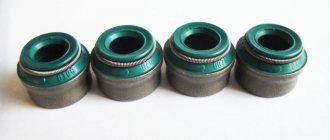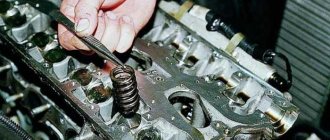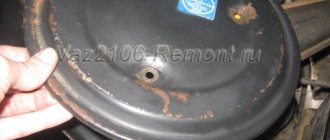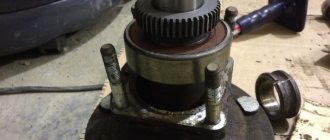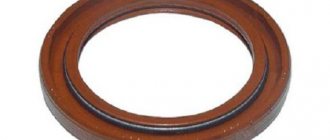Timing valve seals, better known as “oil seals,” prevent oil from entering the combustion chamber from the cylinder head when the valves are opened. Resource of these parts is approximately 100 thousand km., but with aggressive use, the use of low-quality fuels and lubricants and after a long period of engine downtime (more than a year), the oil seals wear out faster. As a result of wear of the seals oil enters the combustion chamber, due to which the engine loses power and operates unstably, oil consumption increases significantly.
We will tell you in this article how to determine the wear of valve seals and how to eliminate it.
Why are valve stem seals needed?
Valve stem seal – this is the name of this part. From its name it follows that it is installed on the valves in the gas distribution mechanism. The purpose of the caps is to prevent engine lubricant from entering the cylinder through an open valve. They look like rubber seals with compression springs.
The number of these parts is identical to the number of valves. When the valve opens the corresponding hole, it should be dry. But at the same time, due to constant friction, the rod must receive the necessary lubrication. Rubber bushings allow both effects to be achieved. Since they are made of elastic material, they wear out as a result of constant mechanical and thermal load, as well as exposure to engine oil.
Cause of smoke in the exhaust pipe
In order to understand the question of why the engine smokes, you need to have an idea of what happens in it during operation.
A fuel mixture is formed in the combustion chamber, which is compressed by the piston and ignited by a spark from the spark plug. The mixture is supplied through the inlet valves, and the spent mixture is discharged through the outlet valves. The pistons have special oil intake rings; they are needed to collect excess oil on the cylinder walls so that it does not enter the combustion chamber.
The engine valves also have special seals (caps), which serve to ensure that the oil located in the cylinder head does not enter the combustion chamber. In addition, spark plugs also play an important role, and if they have a weak spark, or the gaps between the electrodes are incorrectly set, then the fuel mixture in the engine will not burn completely.
Based on this, we can identify the following causes of engine smoke.
- Spark plug . If the spark plugs are faulty, that is, they produce a weak spark, or the gaps between their electrodes are set incorrectly, then the fuel mixture does not burn completely and is discharged from the combustion chamber with blue smoke. In the most severe cases it may be black.
- Piston oil intake rings. As stated above, oil intake rings perform a function related to cleaning the cylinder walls of excess oil so that it does not enter the combustion chamber. They are subject to a powerful frictional force. If they wear out, the oil enters the combustion chamber and ignites along with the fuel mixture. In this case, black smoke appears. Similar functions are also performed by engine rings, which also remove excess oil from the surface of the cylinders and can wear out over time.
- Valve caps. These are seals that serve to prevent the oil in the cylinder head from entering the combustion chamber, and are made of dense rubber. When it wears out, the lubricant enters the combustion chamber and ignites. This produces white (or bluish) smoke.
The last two reasons for smokiness will be discussed below. If a car owner notices the appearance of blue or blue smoke, he needs to pay close attention to the operation of the power unit’s spark plugs and have them diagnosed or replaced.
You need to remember that sometimes the cause of smoke in the exhaust pipe can be bad gasoline. It may contain various additives or additives that will create black or other colored smoke. This problem usually disappears when refueling with other fuel.
How valve stem seals work
The valve stem seal can be made in two different designs:
- Cuff. It fits onto the valve stem and is inserted into its guide. She speaks from the cylinder head. They cost less (compared to the next modification) and can be quickly replaced. The only problem is that dismantling requires a special device.
- Valve seal. It is installed under the valve spring. This element secures the cap and also presses its edges, ensuring stable sealing of the head in this part. These parts are more reliable because they do not experience the same temperature loads as previous analogues. They are also not in direct contact with the guide sleeve, therefore the mechanical load on the cap is less. No special tools are required to replace such modifications. The disadvantage is the high price. If you buy a budget set of caps, you may end up with low-quality elements made from less stable material. Preference should be given to options made of acrylate or fluorine rubber.
In order for the gas distribution mechanism to work without premature wear of the rubbing parts, it must constantly contain motor lubricant (how the timing mechanism is designed and the principle of its operation is described in a separate article ). However, oil should not enter the cylinder cavity.
If the timing belt did not use valve stem seals, the lubricant would be mixed with fuel and air. In its pure form, VTS is removed from the cylinder without residue after combustion. If oil gets into its composition, then this product forms a large amount of soot after combustion. It accumulates on the valve seat. This leads to the fact that the valve no longer presses tightly against the head body, and, as a result, the tightness of the cylinder is lost.

